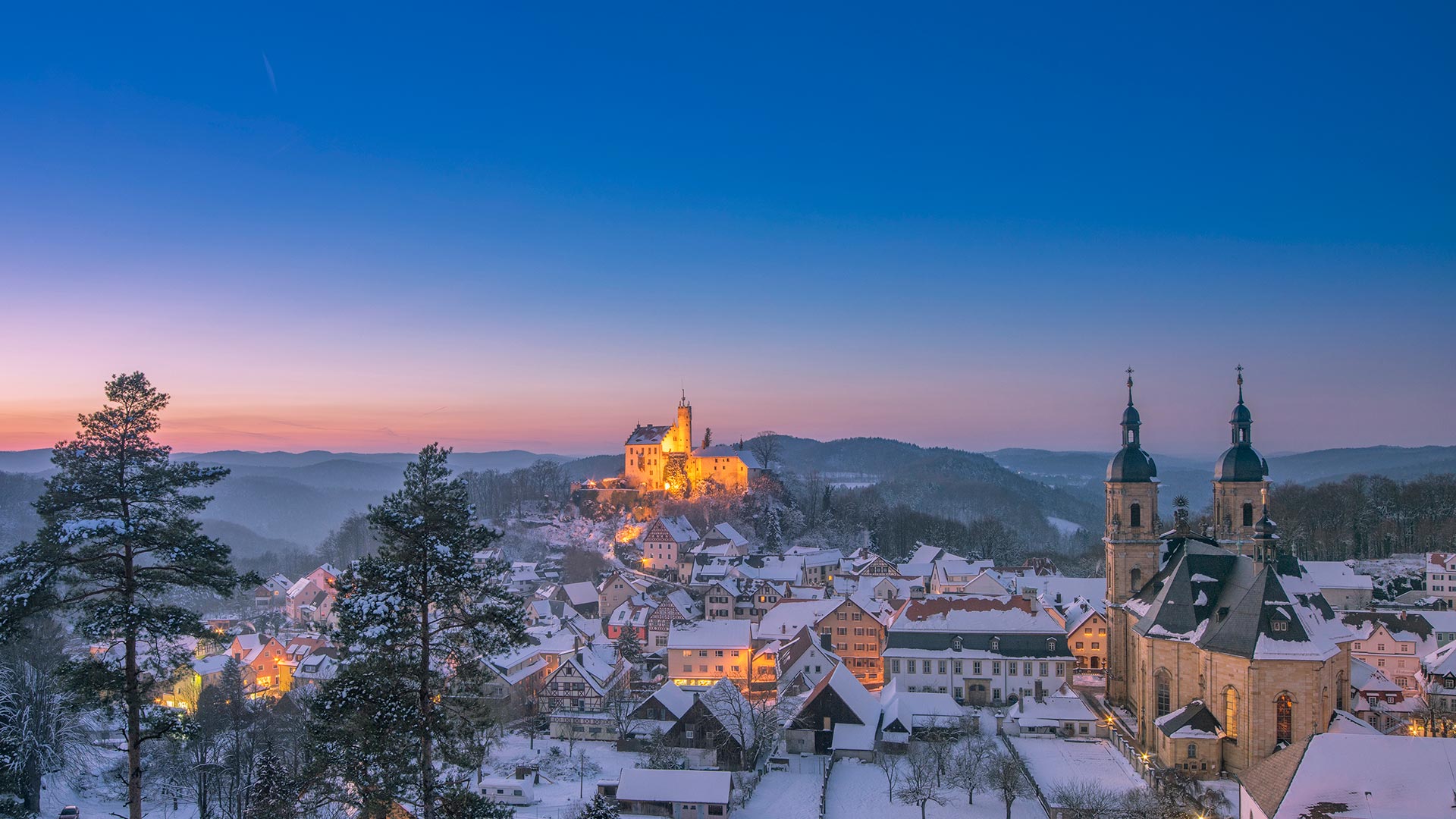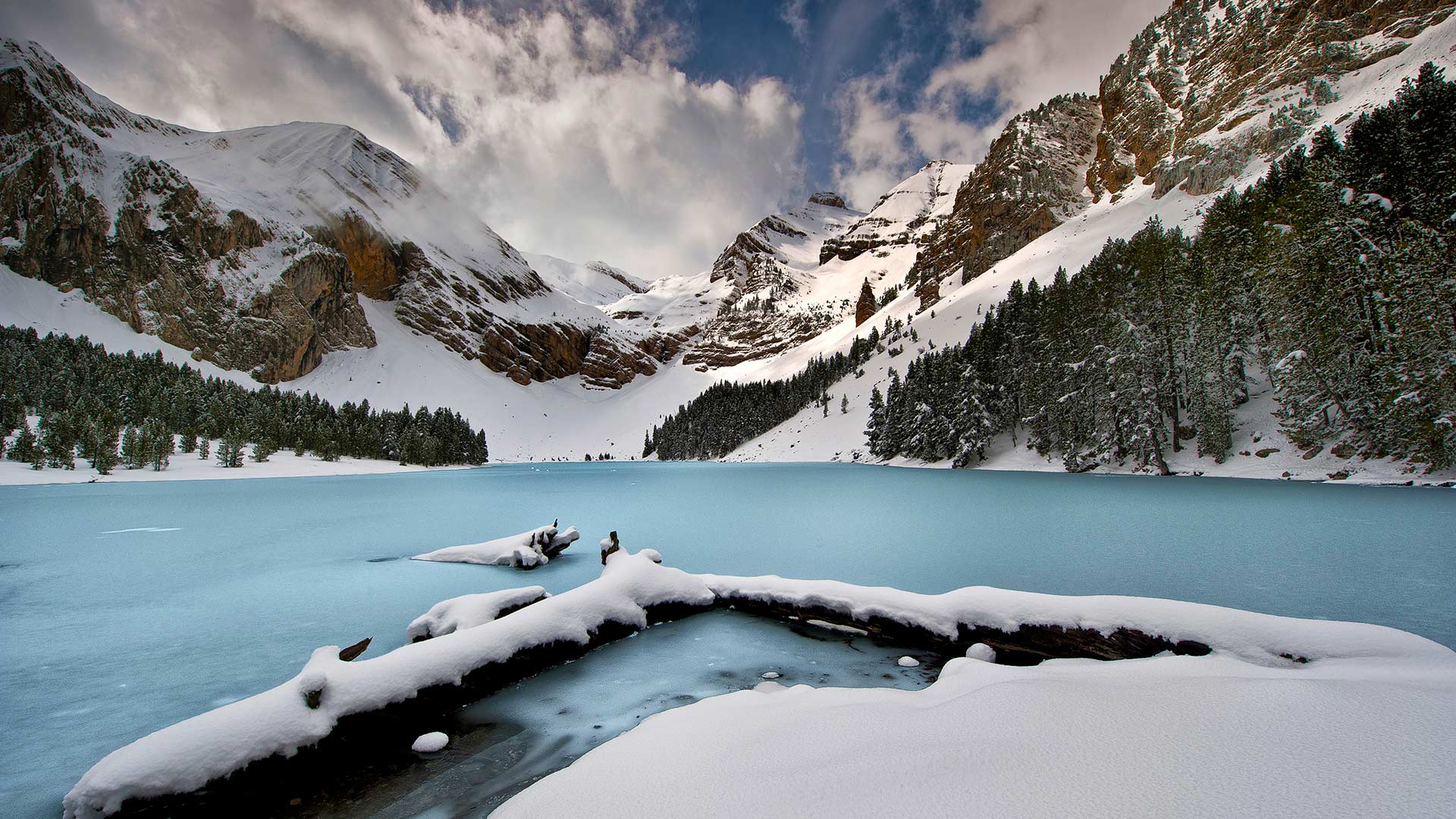远眺格斯韦因斯泰因村和格斯韦因斯泰因城堡 (© Juergen Sack/Getty Images)
峰牙-己榜国家公园中的韩松洞,越南 Sơn Đoòng cave in Phong Nha-Kẻ Bàng National Park, Vietnam (© David A Knight/Shutterstock)
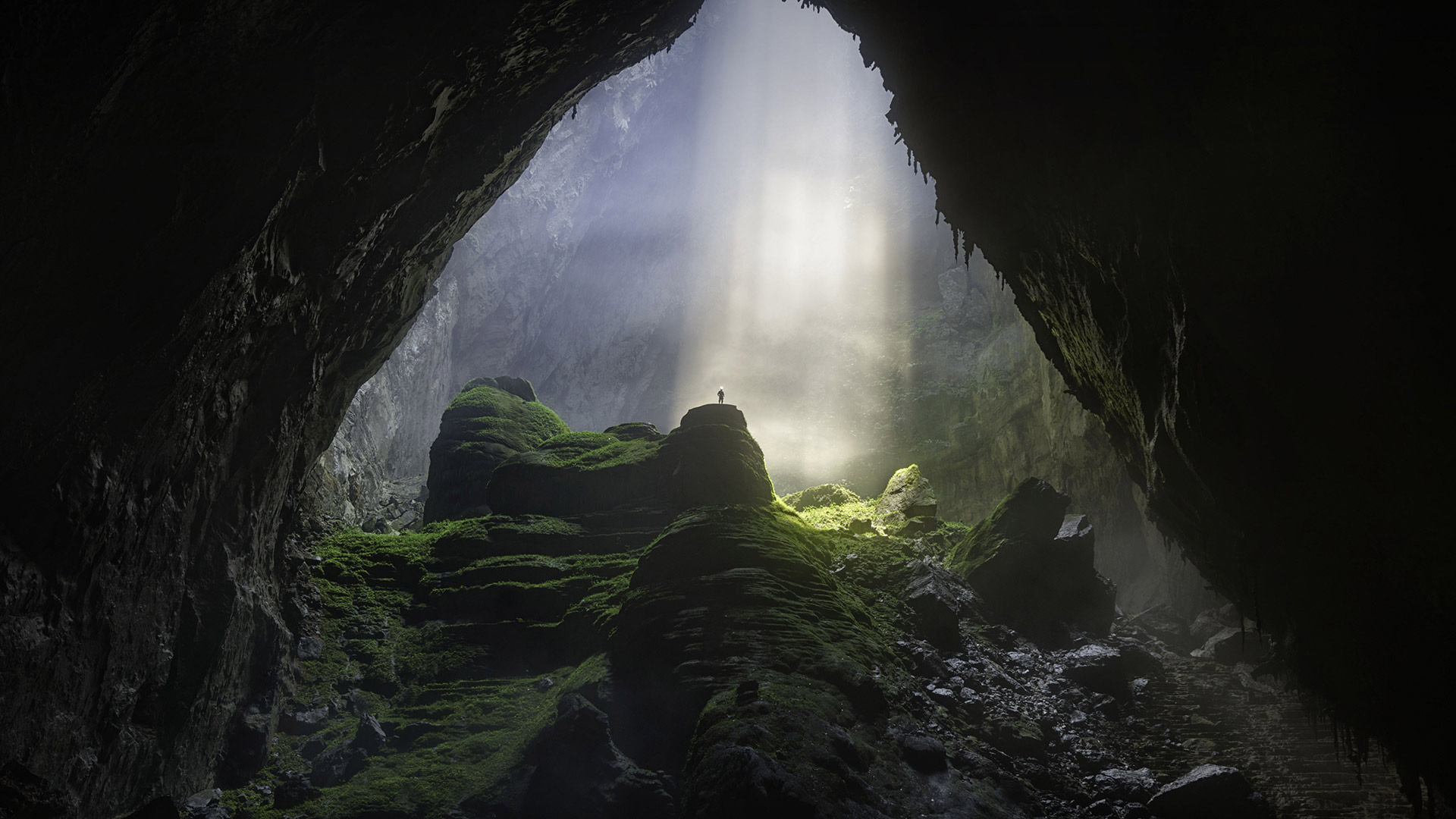
峰牙-己榜国家公园中的韩松洞,越南 Sơn Đoòng cave in Phong Nha-Kẻ Bàng National Park, Vietnam (© David A Knight/Shutterstock)
A universe underground
When Vietnamese farmer Hồ Khanh stumbled upon this cave in 1991, it was immediately clear the gaping mouth led to a huge, dark, untouched chamber, complete with a free-flowing underground river. What couldn't have been clear to him then was that this cave, now known as Sơn Đoòng, is by far the world's largest in volume.
Lacking gear to explore the cave further, Khanh could only wander back home and tell friends about his discovery. But he was unable to retrace his steps to the cavern, his tracks engulfed by the jungle. Relegated to rumor, the cave went unexplored for almost two decades until a visiting team of British cavers caught wind of Khanh's tale. In 2009, Khanh led them to Sơn Đoòng after a long search, and explorations commenced that found the cave was vast beyond anyone's expectations.
Sơn Đoòng is over 1.5 billion cubic feet in volume, with its main chamber 650 feet high, almost 500 feet wide, and stretching more than 3 miles, large enough to fly a Boeing 747 through—but look out for the 15-story stalagmites. One of the cave's massive dolines—sunken, sun-exposed sections like the one seen here—hosts an entire rainforest ecosystem. And that's just what we know so far: Cave divers have yet to fully explore Sơn Đoòng's subterranean river, and vast passages found as recently as 2019 have only added to what's known of the cave's enormity.
地下的宇宙
1991年,当越南农民HồKhanh偶然发现了这个洞穴时,人们立刻清楚地看到,张开的洞口嘴通向一个巨大的、黑暗的、未被触及的洞穴,里面有一条自由流动的地下河。当时他不清楚的是,这个洞穴,现在被称为SơnĐoòng,是迄今为止世界上最大的洞穴。
由于缺乏进一步探索洞穴的装备,卡恩只能漫步回家,告诉朋友他的发现。但他无法回到洞穴,他的足迹被丛林吞噬。由于流言蜚语的影响,这个洞穴在近20年的时间里一直未被发现,直到一队英国探洞者闻到了卡恩的故事。2009年,Khanh带领他们经过长时间的搜寻,来到了SơnĐoòng,开始了探险,发现这个洞穴的面积超出了任何人的预期。
SơnĐoòng的体积超过15亿立方英尺,其主舱室高650英尺,宽近500英尺,长度超过3英里,足以让一架波音747飞机通过,但要注意15层楼高的石笋。洞穴中一条巨大的低谷下陷,暴露在阳光下,就像这里看到的一样,这里有一个完整的雨林生态系统。而这正是我们目前所知道的:洞穴潜水员还没有完全探索sơnĐoòng的地下河,而最近在2019年发现的巨大通道只是增加了人们所知的洞穴的巨大性。
跨年庆典中燃放的烟花,西班牙萨拉戈萨 Fireworks during a New Year's Eve celebration in Zaragoza, Spain (© Martina Badini/Shutterstock)
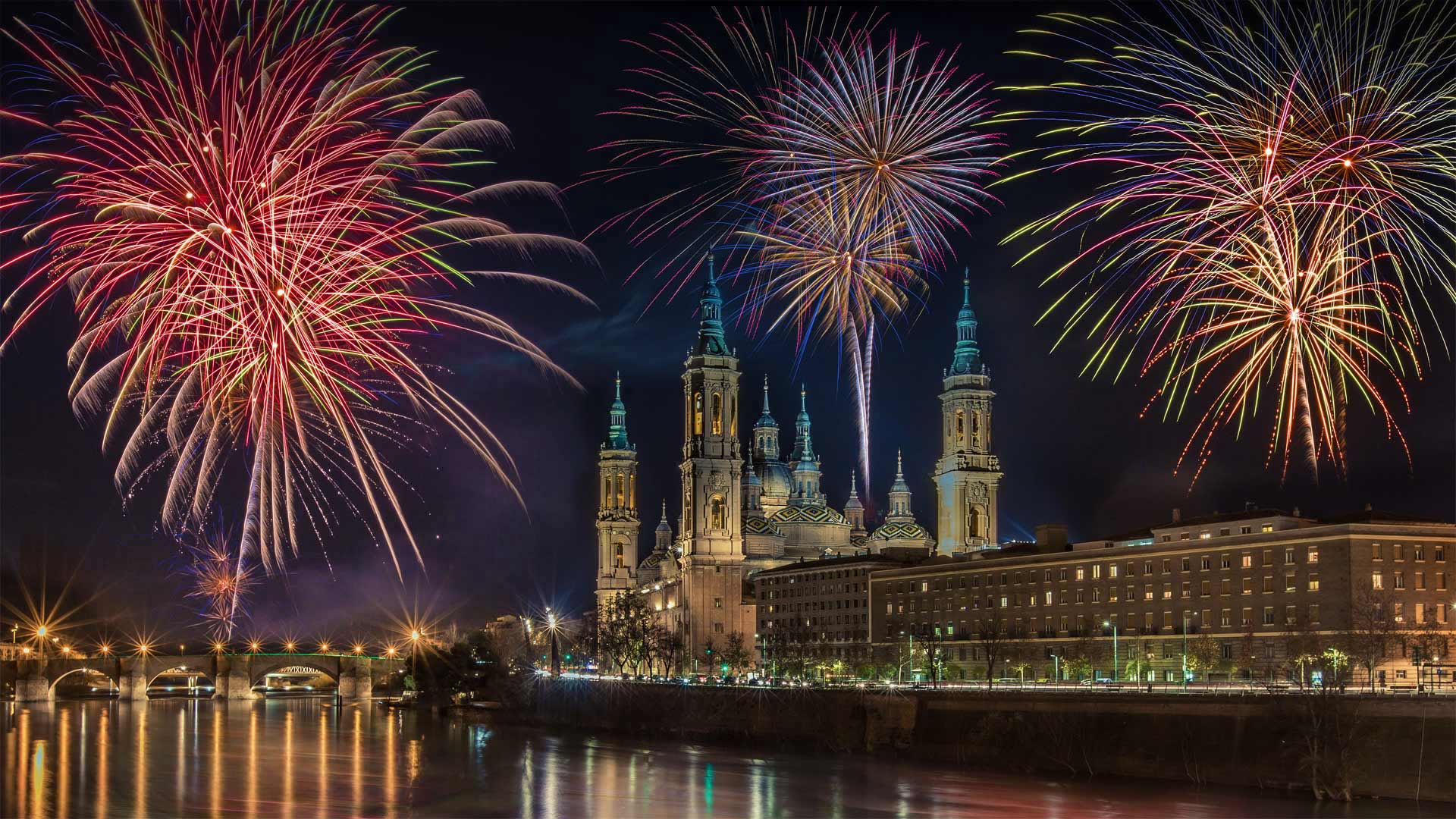
跨年庆典中燃放的烟花,西班牙萨拉戈萨 Fireworks during a New Year's Eve celebration in Zaragoza, Spain (© Martina Badini/Shutterstock)
Goodbye, 2020!
New Year's Eve celebrations around the world will look a lot different this year, but as we ring in 2021 (and bid good riddance to 2020?) we can still enjoy this view of fireworks from a previous year in, Spain. The cathedral in the background is the Basílica de Nuestra Señora del Pilar, which was constructed over centuries beginning in 1681, though several churches had been built on the site prior to that. On the left is the Puente de Piedra Bridge, which spans the Ebro River. It's also known as the Bridge of Lions because statues of lions (symbols of the city) stand at each end of the bridge. Zaragoza is famous for its landmarks and architecture, as well as for local cuisine, and seasonal festivals—which we can only hope return soon.
再见,2020!
今年世界各地的除夕庆祝活动看起来会有很大的不同,但当我们在2021年敲响新年的钟声时(并祝我们在2020年摆脱困境?)我们仍然可以欣赏到前一年在西班牙的烟花。背景中的大教堂是Basílica de Nuestra Señora del Pilar大教堂,这座教堂从1681年开始修建了几个世纪,尽管在此之前已经有几座教堂在此修建。左边是普恩特德皮埃德拉大桥,横跨埃布罗河。它也被称为狮子桥,因为狮子雕像(城市的象征)矗立在桥的两端。萨拉戈萨以其地标和建筑,以及当地美食和季节性节日而闻名,我们只能希望这些节日很快回归。
布莱斯峡谷国家公园的冬天,犹他州 Winter in Bryce Canyon National Park, Utah (© Don Paulson/Danita Delimont)
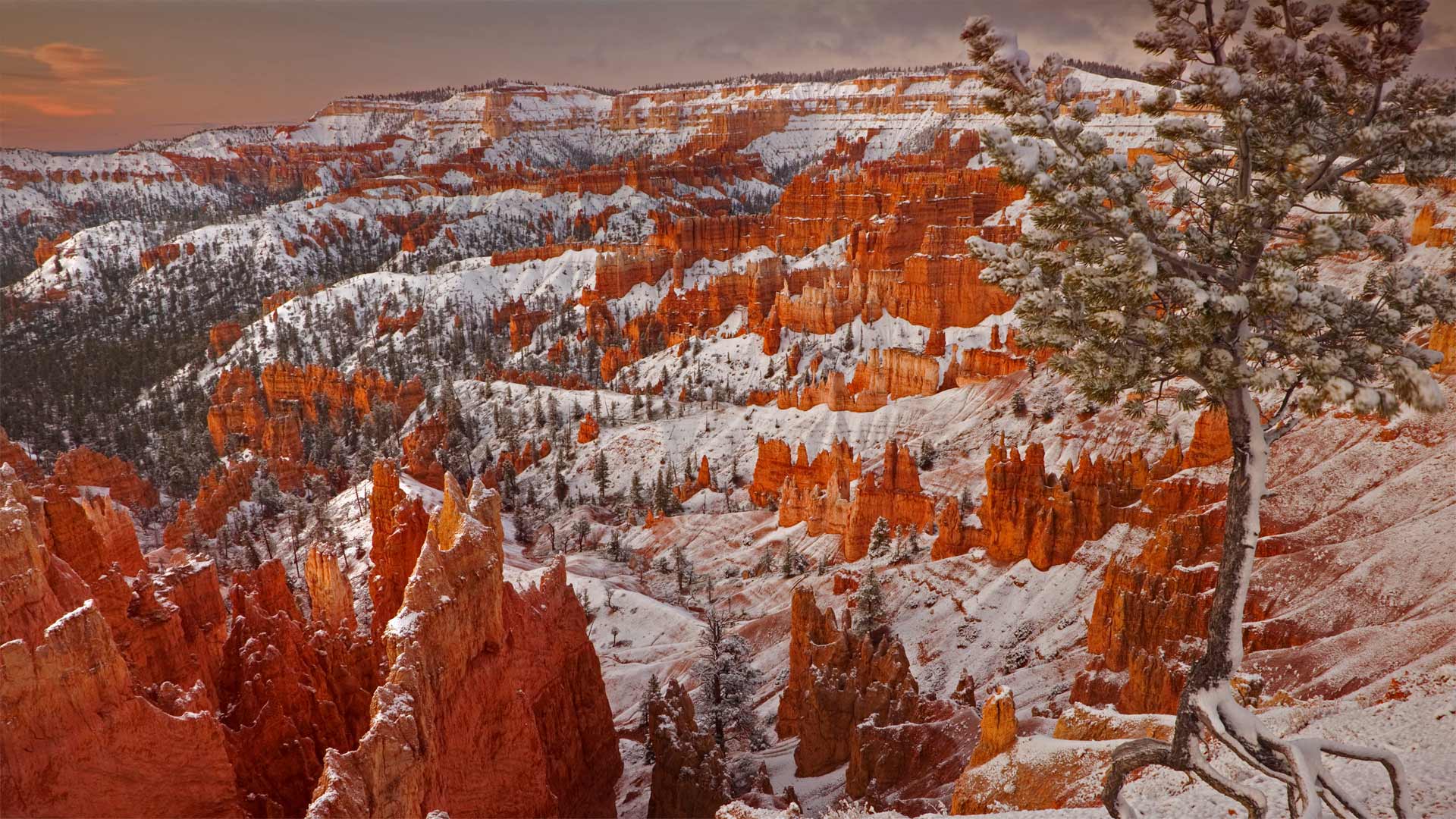
布莱斯峡谷国家公园的冬天,犹他州 Winter in Bryce Canyon National Park, Utah (© Don Paulson/Danita Delimont)
Winter in the Wild West
When considering the dramatically eroded canyons of southwestern Utah, snow may not be the first thing that comes to mind. But far-flung Bryce Canyon National Park gets plenty of the white stuff, owing to its elevation of 8,000-plus feet at the massive amphitheater's rim. The cold not only provides scenic snowy views and great cross-country skiing, it's responsible for the striking red-rock pinnacles—known as hoodoos—that make the park so unique.
High above sea level, winter in Bryce Canyon often sees daily shifts between freezing and above-freezing temperatures. Despite its name, Bryce Canyon isn't a true canyon, but is instead a collection of natural amphitheaters. The park's hoodoos formed as water seeped into massive stone plateaus, then froze and expanded to break away chunks of rock. Repeated day after day for eons, this process has left slim sections of sediment standing throughout Bryce Canyon—now the largest concentration of hoodoos in the world.
狂野西部的冬天
在说到犹他州西南部峡谷为什么受侵蚀严重时,降雪可能并不是第一个被想到的原因。 但是遥远的布莱斯峡谷国家公园(Bryce Canyon National Park)由于在大型圆形剧场的边缘海拔超过8,000英尺而获得了很多白色的东西。 寒冷不仅带来优美的雪景和越野滑雪,而且还造成了令人惊叹的红岩峰(称为石林),使公园如此独特。
布莱斯峡谷的冬天海拔很高,每天都会出现冰点和冰点以上温度的变化。尽管它的名字包含峡谷,但布莱斯峡谷不是一个真正的峡谷,而是一个自然露天剧场的集合。公园的石林随着水渗入巨大的石制高原而形成,然后冻结并扩大以分裂成块的岩石。 这一过程日复一日地重复了亿万年,留下了遍布布莱斯峡谷的薄薄的沉积物,现在布莱斯峡谷是世界上最大的石林聚集地。
卢塞恩老城,瑞士 Old town of Lucerne, Switzerland (© Xantana/Getty Images)
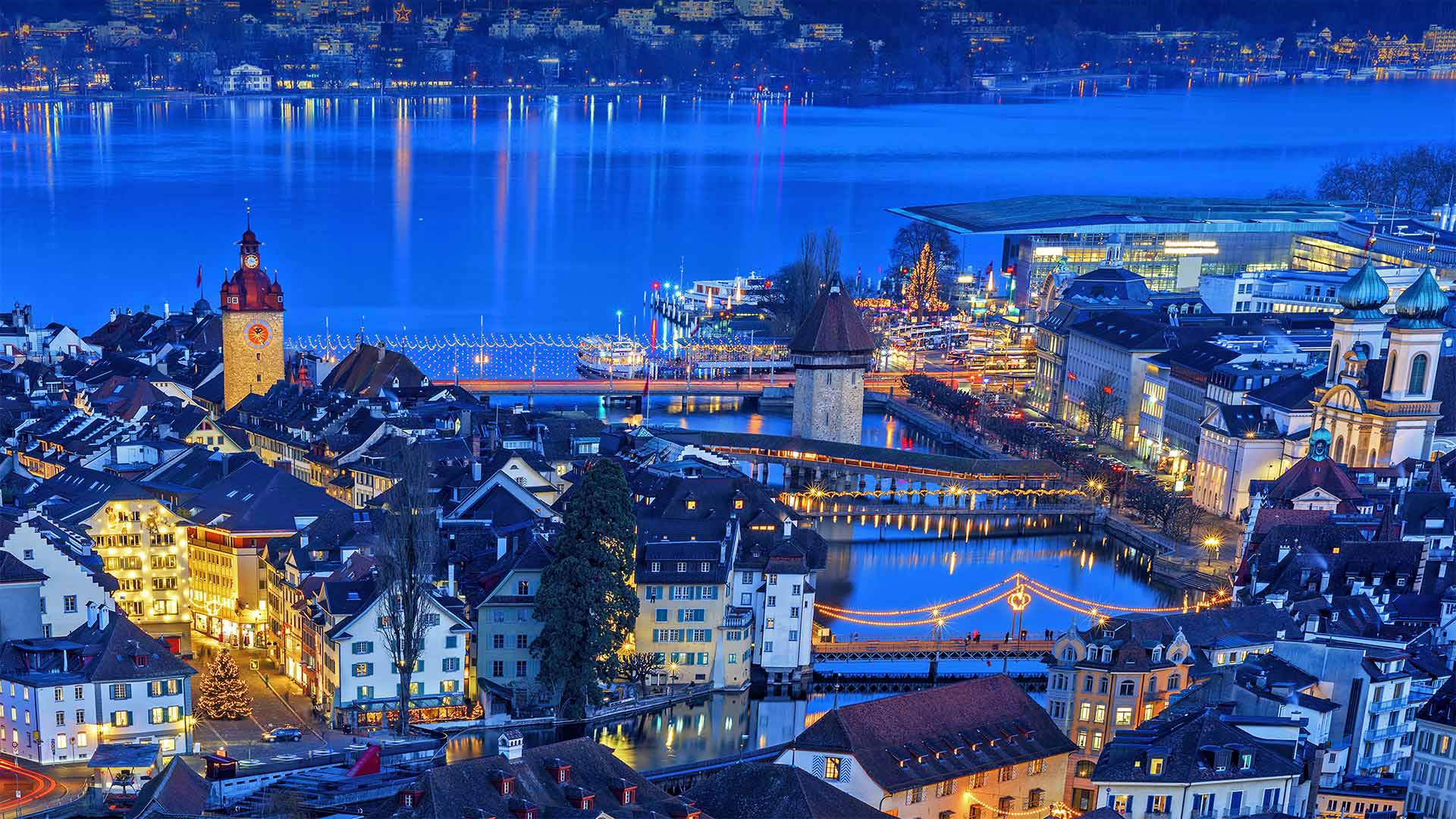
卢塞恩老城,瑞士 Old town of Lucerne, Switzerland (© Xantana/Getty Images)
Where the glow of the holidays lingers
On the shores of Lake Lucerne and bestride the river Reuss, you'll find the medieval Swiss city that shares the lake's name. Emerging from a Benedictine monastery founded here in 750, Lucerne is today the largest town in central Switzerland. The central of three ancient, covered wooden pedestrian bridges of Lucerne's Old Town has a unique feature. The interior of the Kapellbrücke (Chapel Bridge) is painted with religious scenes and allegories to edify those walking across it to the St. Peter's Chapel. Though we are between holidays, the German-speaking city is just getting started. After Christmas and New Year's Day, preparations begin for Fasnacht, the Swiss-German equivalent of Mardi Gras. Just like that carnival, the streets fill up with hundreds of fantastically masked and boisterous marchers, cutting loose before the fast of Lent.
节日的光芒久久不退
在卢塞恩湖(Lake Lucerne)畔,在雷乌斯河(bestride the river Reuss)畔,你会发现这座与湖同名的中世纪的瑞士城市。卢塞恩是瑞士中部最大的城镇,始建于750年,卢塞恩老城区三座古老的木制人行天桥的中心有其独特的特色。Kapellbrücke(教堂桥)的内部绘有宗教场景和寓言,以启迪那些穿过它去圣彼得教堂的人。虽然我们还处于假日期间,但这座说德语的城市才刚刚开始预热。圣诞节和元旦过后,法斯纳赫特的准备工作开始了,法斯纳赫特相当于瑞士和德国的狂欢节。就像那个狂欢节一样,街道上挤满了上百个戴着面具、喧闹的游行者,他们在斋戒前放纵自己。
夜晚的纳巴纳之佐藤花园, 夸纳, 日本 Nabana no Sato garden at night in Kuwana, Japan (© Zoonar GmbH/Alamy)
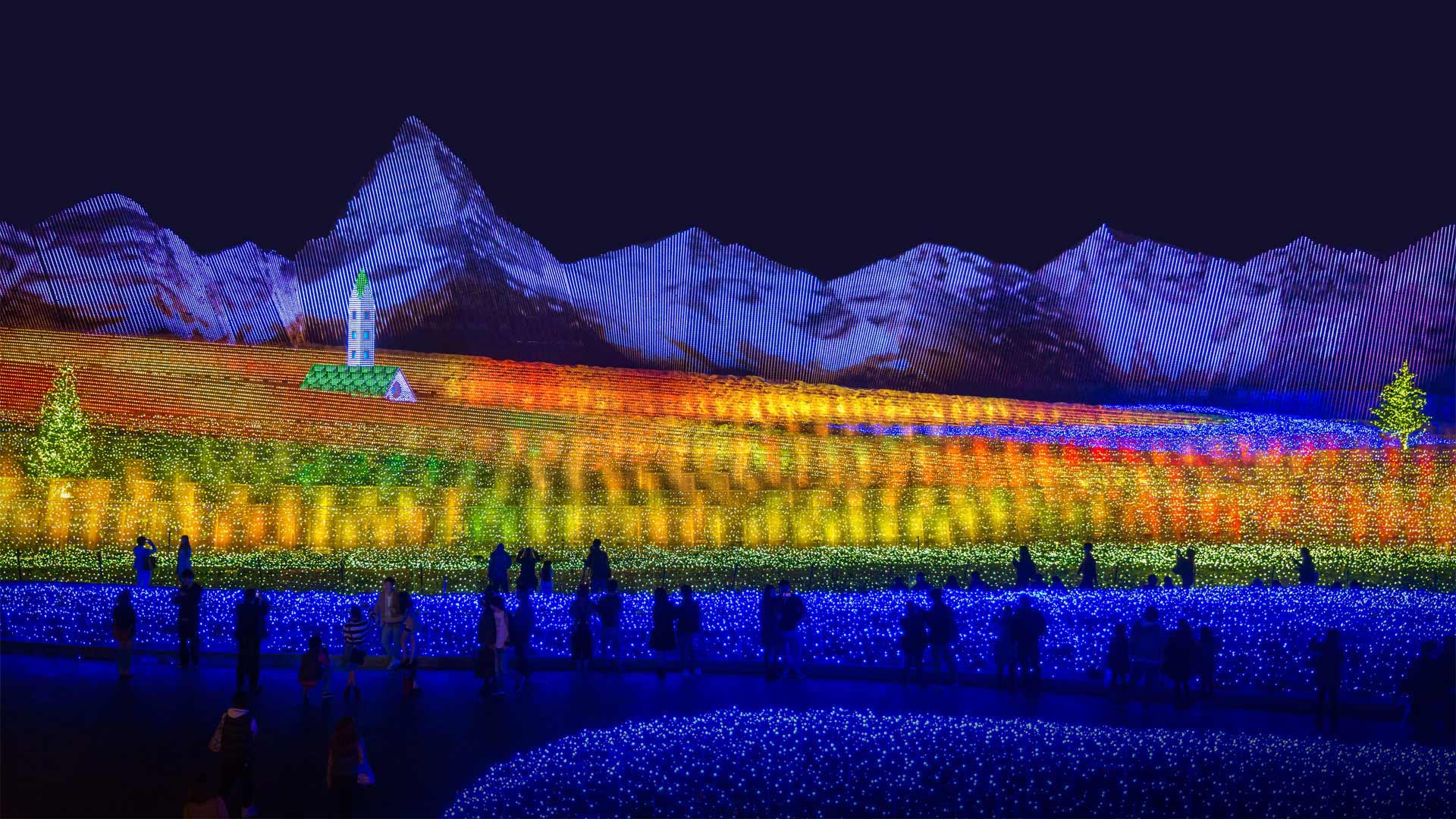
夜晚的纳巴纳之佐藤花园, 夸纳, 日本 Nabana no Sato garden at night in Kuwana, Japan (© Zoonar GmbH/Alamy)
Turning darkness into light
Winter illuminations are a big deal in Japan and there is perhaps no bigger display than the one here at Nabana no Sato, a flower park in the gardens of Nagashima Spa Land in Kuwana, Japan. This image is just a glimpse of what awaits you in the park. More than 8.5 million LED lightbulbs illuminate pathways, trees, and the park's famous 'Tunnel of Lights.' While many of Japan's light displays end after the new year, this one lasts from mid-October through early May.
将黑暗变成光明
在日本,冬季的照明很重要,也许没有什么比在日本的桑名市长岛温泉乐园的花园里的一个花园“纳瓦纳之佐藤”的展览更大。 此图像只是公园里的一瞥。 超过850万个LED灯泡照亮了道路,树木和公园著名的“光之隧道”。 尽管日本的许多灯光展示都是在新年之后结束的,但这个灯展时间是从10月中旬到5月初。
比利牛斯山脉中的高山湖Ibón de Plan,西班牙韦斯卡 (© Getty Images)
Barnett Demesne公园中在白雪覆盖的山坡上玩耍的一家,北爱尔兰贝尔法斯特 Families play on the snow-covered slopes at Barnett Demesne Park, Belfast, Northern Ireland (© Stephen Barnes/Alamy)
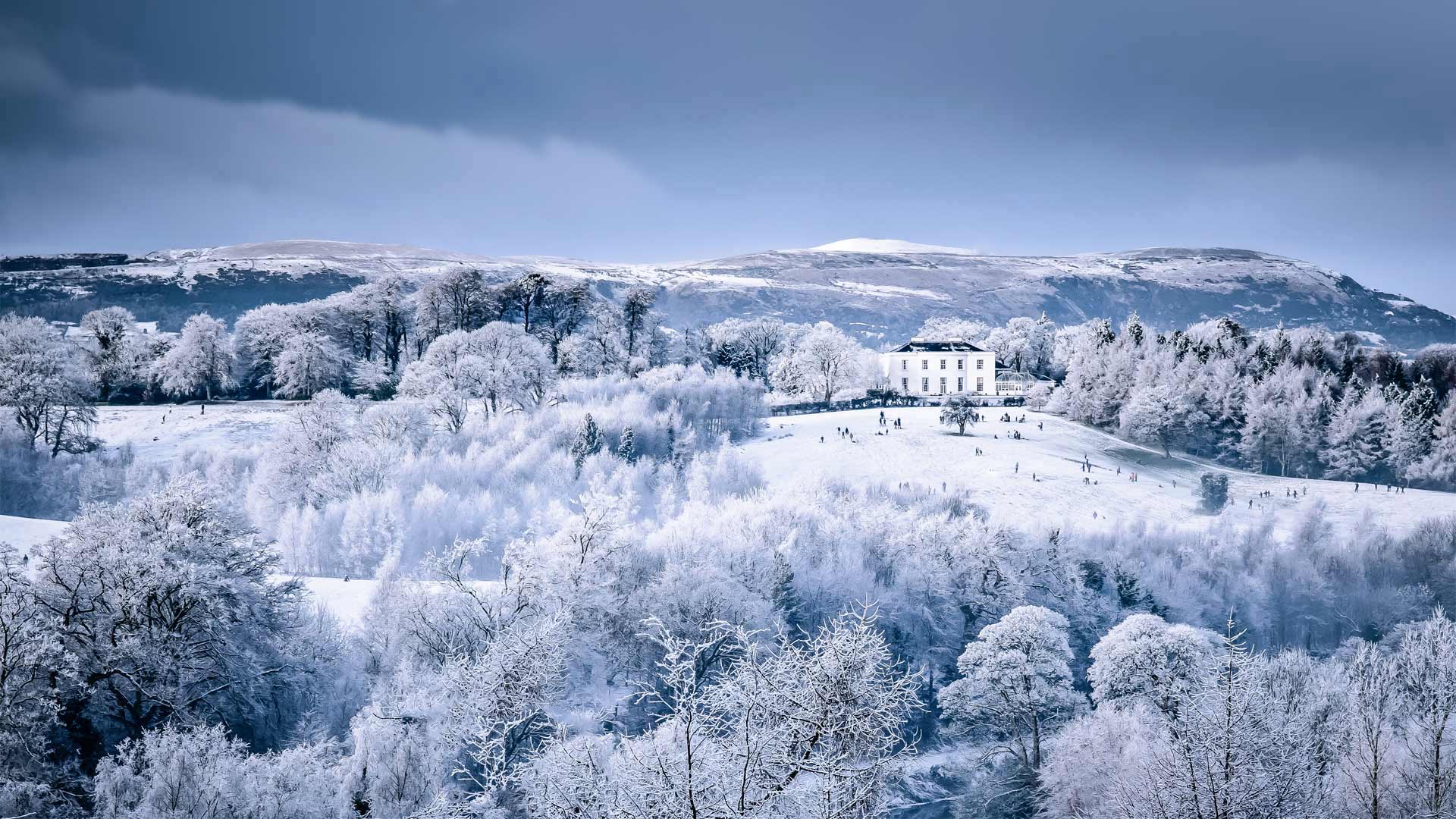
Barnett Demesne公园中在白雪覆盖的山坡上玩耍的一家,北爱尔兰贝尔法斯特 Families play on the snow-covered slopes at Barnett Demesne Park, Belfast, Northern Ireland (© Stephen Barnes/Alamy)
Happy Boxing Day!
That 'Boxing Day (UK)' printed on your calendar's December 26 square has nothing to do with the sport of boxing—although for many modern Brits, Aussies, and other denizens of the Commonwealth, the holiday's full slate of TV sporting events is the main observance. Folks with enough post-holiday energy might even slide down the hills at the grounds of this historic estate-turned public park, Barnett Demesne, in Belfast.
But in older traditions, December 26 was the day nobles and other property owners offered gifts to servants and employees. It's not clear if 'boxing' refers to the boxes that held these presents, or to donation boxes customarily set up for the poor on the holiday—nor if these were so much gifts as reminders of one's place on the feudal social ladder. But at any rate, as you shop those big sales and munch those tasty leftovers today, consider paying homage to Boxing Day's origins by doing a good turn for someone down on their luck.
节礼日快乐!
尽管对许多现代英国人、澳大利亚人和其他英联邦居民来说,这个节日的主要庆祝活动是一系列的电视体育赛事,但印在日历12月26日方格上的“节礼日(英国)”与拳击运动毫无关系。在贝尔法斯特的巴尼特德梅斯内,有足够精力的人甚至可能会在这个历史悠久的庄园改造成的公共公园里滑下山来。
但在古老的传统中,12月26日是贵族和其他财产拥有者向仆人和雇员赠送礼物的日子。目前还不清楚“拳击”是指装这些礼物的盒子,还是指节日里为穷人设立的捐款箱,也不清楚这些礼物是否只是提醒人们自己在封建社会中的地位。但不管怎样,当你今天在那些大卖场购物,大嚼那些美味的剩菜时,不妨考虑为那些运气不好的人做一个好运祝福,以此向节礼日的起源致敬。
Sindhudurg堡(信德古德堡), 印度马哈拉施特拉邦 Sindhudurg Fort, Maharashtra, India (© MovingMaratha/Alamy)
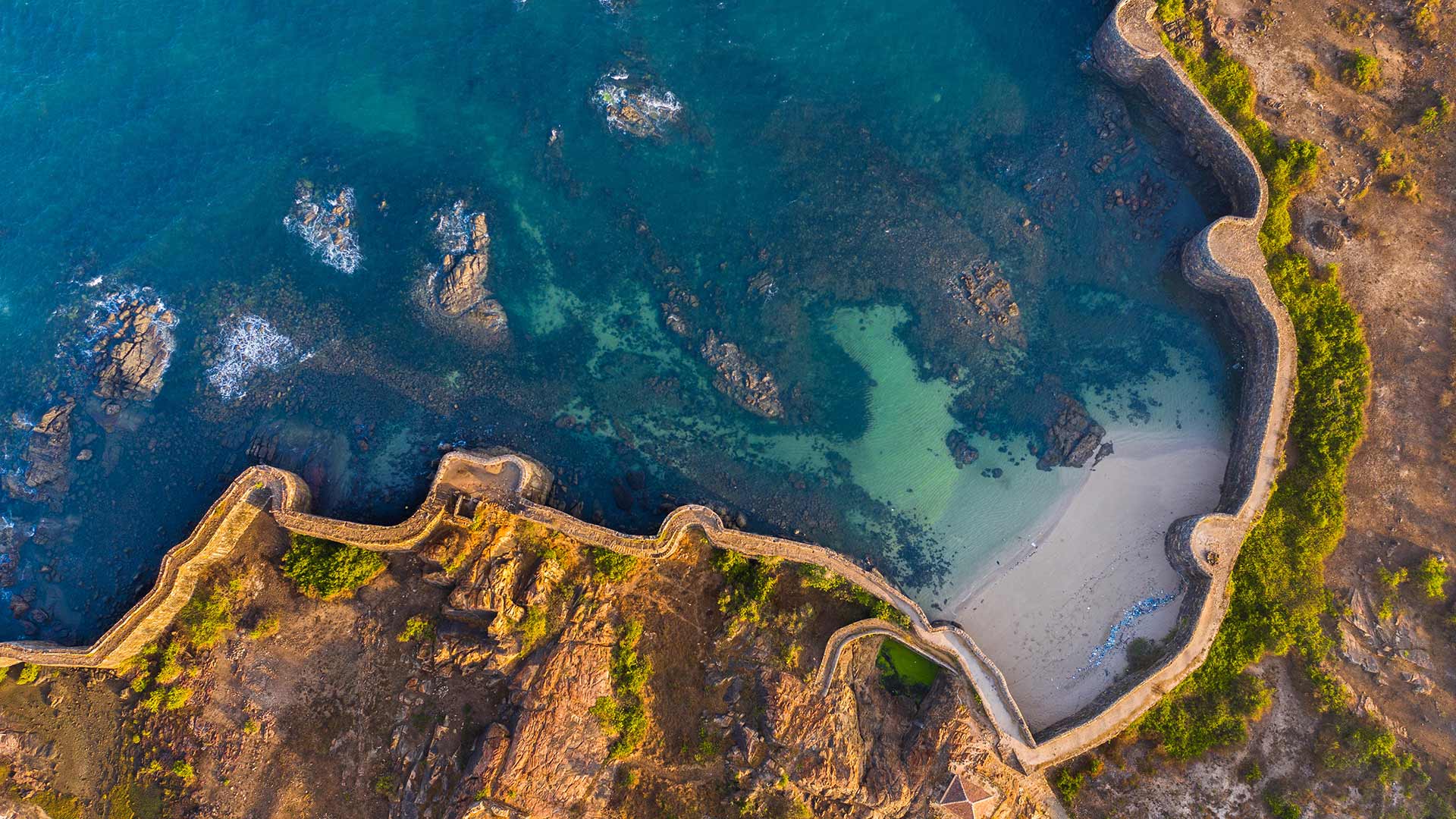
Sindhudurg堡(信德古德堡), 印度马哈拉施特拉邦 Sindhudurg Fort, Maharashtra, India (© MovingMaratha/Alamy)
A historical fort
Sindhudurg Fort is a historical fort that occupies an island in the Arabian Sea, just off the coast of Maharashtra in Western India. The fort was built by chhatrapati Shivaji Maharaj . The fortress lies on the shore of Malvan town of Sindhudurg District in the Konkan region of Maharashtra. It is a protected monument.
历史要塞
信德古德堡(Sindhudurg Fort)是一座历史悠久的要塞,坐落在阿拉伯海的一个岛屿上,就在印度西部马哈拉施特拉邦的海岸附近。 堡垒由贾特拉帕蒂·希瓦吉·马哈拉杰(Chhatrapati Shivaji Maharaj)建造。 这座堡垒位于马哈拉施特拉邦康坎地区信德堡区马尔万镇的岸边。它是一座受保护的纪念碑。
涅迪克角灯塔上的节日彩灯,缅因州 Holiday lights on Cape Neddick Light in York, Maine (© Walter Bibikow/Alamy)
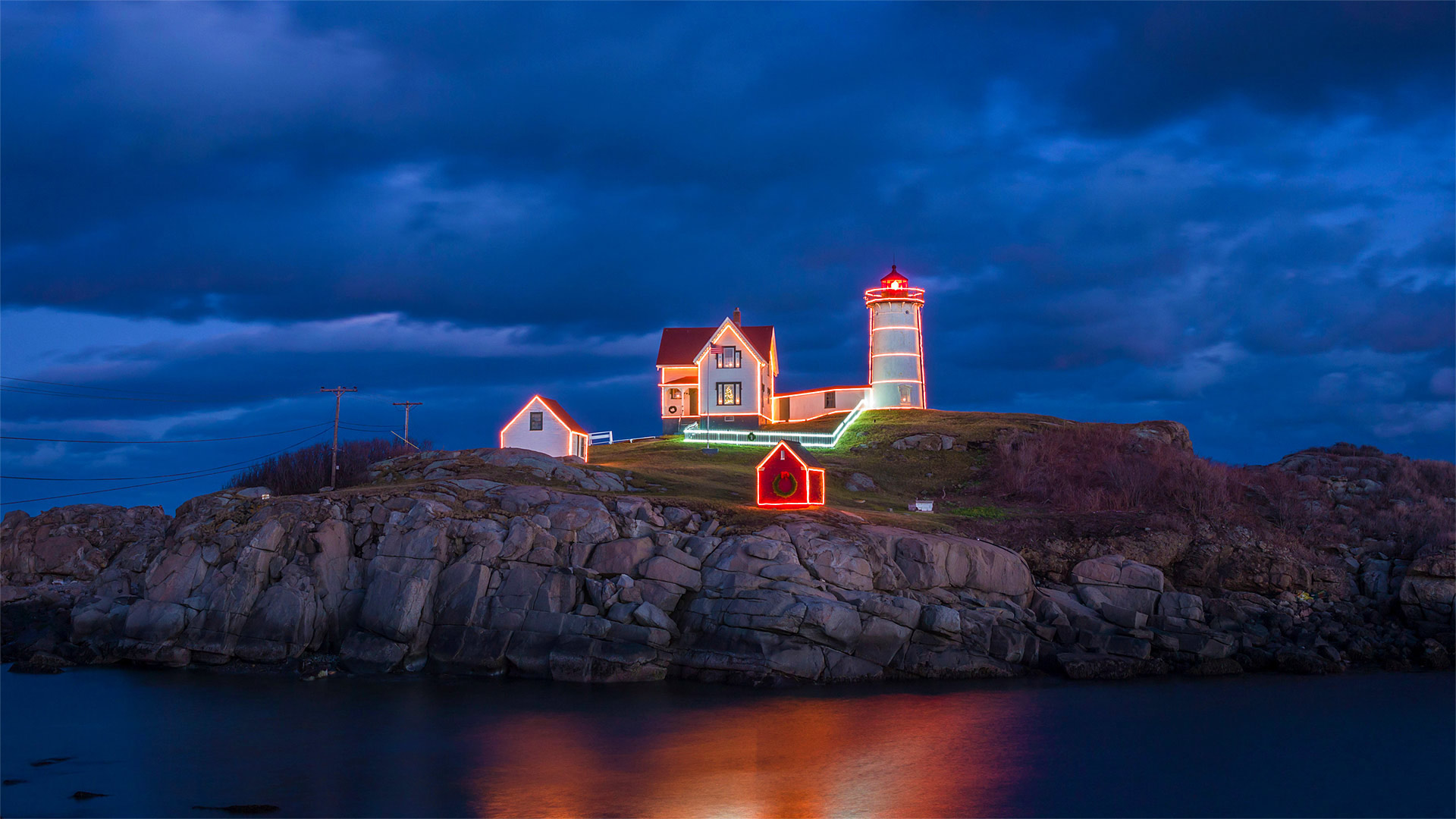
涅迪克角灯塔上的节日彩灯,缅因州 Holiday lights on Cape Neddick Light in York, Maine (© Walter Bibikow/Alamy)
A holiday beacon of light
This classic New England scene is Cape Neddick Light, one of Maine's most iconic lighthouses, all lit up for the holiday season. Every year on the Saturday after Thanksgiving, hundreds gather on the mainland across from tiny Nubble Island to count down to the lighting. It is quite the holiday tradition, complete with Santa, live reindeer, and thousands of cookies baked by locals.
'Nubble Light,' or 'the Nub,' is arguably the most iconic of Maine's 65 lighthouses. Built on more than two acres of granite island, the Nub has been protecting sailors since 1879. There's no better time to visit than when it's all dressed up for the holidays. And if you miss the winter display, you can come back in July, when it's relit for summer visitors.
节日的灯塔
这个经典的新英格兰场景是涅迪克角灯塔,缅因州最具标志性的灯塔之一,在节日期间灯火通明。 每年感恩节后的星期六,数百人聚集在努布尔岛对面的大陆上,为灯光倒数。这是一个相当传统的节日,有圣诞老人,驯鹿和当地人烤的成千上万的饼干。
“纽伯灯”或“纽伯”可以说是缅因州65座灯塔中最具标志性的。 Nub建于2英亩以上的花岗岩岛上,自1879年以来就一直为水手们提供保护。没有比盛装过节更好的时间了。 如果你错过了冬季的展览,你可以在7月回来,那时灯塔会为夏季游客重新点亮。
